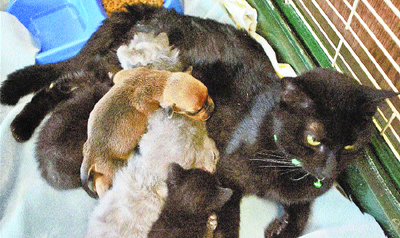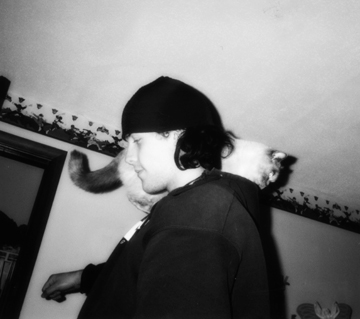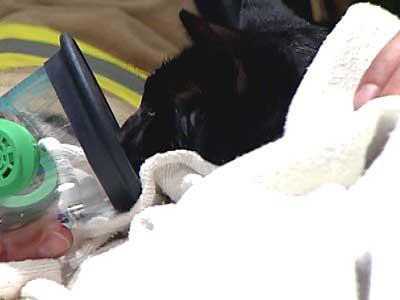You are currently browsing the category archive for the ‘Help the Animals’ category.
I saw the article first in the paper I work for and wanted to blog about it. Unfortunately I haven’t gotten around to blogging much this past week and it’s been a bit. I still think it’s a great heartwarming story and should be told…
In Meriden, CT at the CT Humane Society… a mother cat who just gave birth to kittens adopted a 6 day old Rottweiler puppy that was abandoned by it’s mother. The pup is named Charlie. Charlie’s mother was found by the side of the road in Meriden a couple of months ago. She gave birth to two puppies, but one was stillborn. As sometimes happens with a stillborn in the litter, the mother refused to accept Charlie. “The kittens scrum up with him and the kittens treat him like one of their own,” Chorney said. “There’s a certain social benefit of small animals being with each other.” Volunteers are hoping that dog owners will volunteer their puppies to be Charlie’s playmates. “Dogs need to be with a litter of puppies, to learn to play with other dogs,” Chorney said. “He has to learn to be a well-socialized dog. Here is the Meriden Humane Society’s website. Also, here is the article about the whole situation.
And a photo:
And a video!
I have gotten the worst news today that has sent me spiraling into a depression. You will have to excuse me if I slack a bit on the posts for the next couple days since I haven’t been too happy about this news. My kitty “Skittles” (she is half Siamese, half Persian and gorgeous) has Feline Leukemia. It is in the 1st stage of the virus and could live 3 more healthy years (on the bright side) but that doesn’t mean she will. You wouldn’t even be able to tell she had anything wrong with her as she looks and acts the same as she ever did. The bad news came from a regular Vet checkup. It’s good that it was caught early because the 2nd stage only means bad things for our furry friends. I have decided to post a few facts about this virus for everyone’s information… it will show also what to look for (as in signs)… although I would urge everyone to just bring their pet for regular checkups because my baby isn’t showing any signs at all but she still tested positive.
What is Feline Leukemia Virus?
Feline Leukemia Virus (FeLV), a retrovirus, so named because of the way it behaves within infected cells. All retroviruses, including feline immunodeficiency virus (FIV) and human immunodeficiency virus (HIV), produce an enzyme, reverse transcriptase, which permits them to insert copies of their own genetic material into that of the cells they have infected.
How common is the infection?
FeLV-infected cats are found worldwide, but the prevalence of infection varies greatly depending on their age, health, environment, and lifestyle. In the US approximately 2 to 3% of all cats are infected with FeLiv. Rates rise significantly – 13% or more – in cats that are all, very young, or otherwise at high risk of infection.
How is FeLV spread?
Cats persistently infected with FeLV serve as sources of infection. Virus is shed in very high quantities in saliva and nasal secretions, but also in urine, feces, and milk infected cats. Cat-to-cat transfer of virus may occur from a bite wound, during mutual grooming, and (although rarely) through the shared use of litter boxes and feeding dishes. Transmission can also take place from an infected mother cat to her kittens, either before they are born or while they are nursing. FeLV doesn’t survive long outside a cat’s body – probably less than a few hours under normal household conditions.
What does FeLV do to a cat?
Feline Leukemia virus adversely affects the cat’s body in many ways. It is most common cause of cancer in cats, it may cause various blood disorders, and it may lead to a state of immune deficiency that hinders the cat’s ability to protect itself against other infections. The same bacteria, viruses, protocoa, and fungi that may be found in the everyday environment – where they usually do not affect the healthy animals – can cause severe illness in those with weakened immune systems. These secondary infections are responsible for many of the diseases associated with FeLV.
What are the signs of disease caused by FeLV?
During the early stages of infection, it is common for cats to exhibit no signs of disease at all. However over time – weeks, months or even years – the cat’s health may progressively deteriorate or be characterized by recurrent illness interspersed with periods of relative health. Signs may include:
- Loss of appetite
- Slow but progressive weight loss, followed by severe wasting late in the disease process
- Poor coat condition
- Enlarged lymph nodes
- Persistent fever
- Pale gums or other mucus membranes
- Inflammation of the hums (gingivitis) and mouth (stomatitis)
- Infection of the skin, urinary bladder, and upper respiratory tract
- Persistent diarrhea
- Seizures, behavior changes, and other neurological disorders
- A variety of eye conditions
- In unspayed female cats, abortion of kittens or other reproductive failures
What are the two stages of FeLV infection?
FeLV is present in the blood (a condition called viremia) during two different stages of infection:
Primary Viremia, and early stage of the virus infection. During this stage some cats are able to mount an effective immune response, eliminate the virus from the bloodstream, and halt progression to the secondary viremia stage.
Secondary Viremia, a later stage characterized by persistent infection of the bone marrow and other tissue. If FeLV infection progresses to this stage, it has passed a point of no return: the overwhelming majority of cats with secondary viremia will be infected for the remainder of their lives.
How can I keep my cat from becoming infected?
The only sure way to protect cats is to prevent their exposure to FeLV infected cats.
- Keep cats indoors, away from potentially infected cats that might bite them. If you do allow your cat outdoor access, provide supervision or place them in a secure enclosure to prevent wandering and fighting.
- Adopt only infection-free cats into households with uninfected cats.
- House infection-free cats separately from infected cats, and don’t allow infected cats to share food and water bowls or liter boxes with uninfected cats.
- Consider FeLV vaccination of uninfected cats (FeLV vaccination of infected cats is not beneficial). Discuss the advantages of vaccination with your veterinarian. FeLV vaccines are widely available, but since not all vaccinated cats will be protected, preventing exposure remains important even for vaccinated pets. FeLV vaccines will not cause cats to receive false positive results on ELISA, IFA or any other available FeLV tests.
I hope this has helped inform you of the risks out there and to seriously consider getting your cat vaccinated. I never thought it would happen to my cat and it did. She hardly left the yard when she went outside, she was a scaredy cat about roaming around the neighborhood, and still she caught it. Please do me a favor and check on your cat… if everyone took better care and diagnosed their cat, this wouldn’t be becoming more of a common problem. I now have to keep Skittles indoors and worry about her getting all sorts of infections bringing her to the vet every few months. I wouldn’t wish this on anyone.
This is my skittles… her eyes are light blue, so it’s hard to get a good photo of her eyes looking normal:
She also loves to sit on your shoulder like a bird ever since she was a kitten. Here she is with my boyfriend… chilling on his shoulder:
Here’s a terribly sad story that I am reluctant to bring to everyone’s attention. Unfortunatly I feel as if these pets who died should be mourned. At the Seminole County Animal Services building in Sanford, Florida a fire was started and the suspected cause of the blaze was a clothes dryer. Firefighters came to the rescue but couldn’t save all the animals in time. 32 cats and 7 dogs were killed. There were around 270 animals that survived and were treated on the scene and expected to live. It is sad to hear of this tragedy and all we can do is mourn for the lifes lost. Here is the article.
And here are some photos of the survivors…
That’s right! Fabruary is National Pet Dental Month. This is SO important because so many pet owners tend to neglect this part of their animals health. Animals are very prone to getting oral diseases if not properly cared for and on a regular basis.
“According to the AVDS, 80 percent of dogs and 70 percent of cats show signs of oral disease by age three, often indicated by bad breath, a change in eating or chewing habits, pawing at the face and mouth and depression. Besides causing receding gums and tooth loss, the infection may enter the bloodstream, potentially infecting the heart, liver and kidneys.”
If you own a pet please check out this site which has a bunch of useful information about Pet Dental Care. Take care of those little fuzzy love bugs! They depend on YOU!
I know my blog is about cuddly, cute, adorable animals but when those animals become victim to horrible deaths, I can’t let this go unnoticed. I not only want to brighten someones day with pictures, videos and stories of the cute and adorable but also to inform people of animals in the news, how to help them and to know what’s going on in the “animal world”. Sometimes this comes with hard to hear news, like this bombing in the Baghdad pet market. What annoys me the most was the fact that when I first read about it, there were death and injury tolls of people but hardly anything was said about the animals involved. I am not trying to say anything here about whose life is more important, but I do believe it would do some good if people were aware that humans are not the only victims of war. Here is a news article from CBS about the bombing (and after reading it, you will see what I mean).
After looking into the story a bit, I found some videos I would have rather not watched from the war regarding animals. It may have not had anything to do with this particular case but I started to realize how much the animals were suffering due to this war… something I didn’t even think about (being a huge animal lover). In the videos you will find animal cruelty to a huge degree. One shows an American soldier throwing stones at an injured dog just for fun. Another shows live donkey being fed to a lion with many onlookers (this in a Baghdad zoo). Thinking about these videos, I realized that the animals the were in the Pet Market were probably just left there (especially if they weren’t even mentioned in any of the articles). Doesn’t anyone care? Are there no reporters who have a soft spot for animals?
This said, it is up to you if you would like to view these videos I have mentioned. I am not placing them on the blog directly due to the content. It is not easy to watch, I warn you. I don’t recommend it, but if anything… if it brings enlightenment so be it. It should be known they are victims of cruelty just as much as people are over there. I hope something can be done about this.
This video reminded me of Gladiator times with the lion… it’s so awful… particularly the audience cheering in the background and with comments like “this is f*ckn awesome”, shame on them!!!:
http://www.youtube.com/watch?v=cXEePi7a2Pw
These soldiers torturing an injured dog is just plain sadistic. I can’t believe my eyes.

 Looks like everyone is hurting from the economy, even animal rescue agencies. These agencies rely heavily on private donations and are struggling with an unprecedented increase in abandoned animals along with a drop in donations. Many shelters which spay and neuter feral cats, don’t have enough money to help out in the upcoming seasons.
Looks like everyone is hurting from the economy, even animal rescue agencies. These agencies rely heavily on private donations and are struggling with an unprecedented increase in abandoned animals along with a drop in donations. Many shelters which spay and neuter feral cats, don’t have enough money to help out in the upcoming seasons.


































